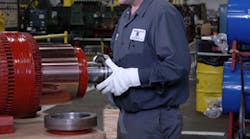Electric motor failures are often caused by “in-operation” factors, such as production activities and the factory environment in which they operate. Other failures are due to “off-line” factors, including inadequate or substandard motor repair practices, and improper motor shipping, storage, and installation. Compared with in-operation failures, those caused by off-line factors are much easier to eradicate — and represent an overlooked opportunity to improve electric motor reliability.
To capitalize on this opportunity, your company should evaluate and work with electric motor rebuilders based on their adherence to high-quality repair standards and practices. It's important to remember that the expertise, professionalism, and overall quality offered by electric motor repair companies can vary significantly from shop to shop — and also over time. Regardless of size or location, however, expert repair shops share many of the same characteristics. When choosing a provider, look for the following traits:
-
Maintains clean, orderly work areas and has a stable workforce of well-trained, technically proficient employees (Photo 1).
-
Is fully equipped with state-of-the-art test equipment and instruments. Expert shops will calibrate their instruments annually to National Institute of Standards and Technology (or equivalent) standards to ensure the accuracy of repair readings and measurements.
-
Adheres to a documented set of repair procedures. High-quality motor shops are procedure driven and never rely solely on the skills and experience of shop technicians. These providers have developed detailed procedures covering electric motor repairs and document each step of the repair process. This helps ensure your motors are repaired or rebuilt to documented mechanical and electrical standards every time, regardless of when repairs are made or who made them.
-
Use high-quality replacement components procured through transparent supply channels. This alleviates customer concerns about obsolete or counterfeit components that may result in poor motor performance.
Repair procedures
Among other actions, the procedures followed by high-quality shops include conducting a stator core test before and after winding removal, as well as confirming that the core has not been damaged during the repair process. Core loss testing and “hot-spot” testing are vital when it comes to determining the condition of the AC induction motor stator iron integrity. Operational costs and long-term stator winding reliability are the primary considerations. Core losses decrease the efficiency of electric motors and can increase a plant's utility costs.
Leading motor shops spend considerable time and resources on electrical and mechanical acceptance testing. State-of-the-art acceptance testing requires a significant investment in test instruments, but is highly recommended as a way of detecting problems before the motor leaves the shop and is returned to service. Electrical acceptance procedures include insulation resistance (IR) testing, high-potential testing, stator winding resistance imbalance, polarization index (PI), step voltage, and surge testing. Mechanical acceptance procedures include vibration spectrum analysis, shaft end runout, soft foot testing, and rotor balancing. Rotor balancing should reference an ISO balance grade to ensure established balancing standard. Qualified shops are equipped to test-run electric motors at rated voltage because tests at reduced voltage may fail to reveal certain problems.
Certifying electric motor shops
A few select motor shops have earned special certification in motor rebuild and repair from motor and rotating-equipment technology companies. Under the certification, these exclusive and highly professional shops agree to adhere to technical requirements covering all aspects of motor repair. Employees participate in intensive training, focusing on key factors that influence motor performance and motor service life. Shop personnel refine their skills in analyzing motor problems and identifying the root causes of motor failures. Root-cause analysis seeks to identify the underlying sources of motor problems and to propose solutions that will prevent problems from recurring.
To complete certification, the repair shops typically undergo a stringent quality audit covering the following: work orders and processes; quality control; equipment calibration; storage of consumables, work in progress and serviced motors; motor assembly/disassembly procedures; machining practices; tools and instrumentation; lubrication practices (Photo 2 on page 18); cleanliness and housekeeping; mechanical and electrical motor conformance testing; and correct shipping procedures. In addition, some certification programs require the shops to complete a shaft and housing measurement test to assess the mechanical measurement capabilities of its employees. Many shops also participate in continuous improvement efforts and undergo recertification every year or two.
Enhancing quality standards
Electric motor repair shops with an ongoing commitment to high-quality standards are the ones most likely to earn certification. This was the case with Electrical Repair Service Co., Inc. of Birmingham, Ala. The 90-year-old company has a customer base consisting mainly of pulp and paper producers, mining operations, and cement and aggregate plants. According to the company's general manager, Kirk Kirkland, the certification process and requirements dovetailed with Electrical Repair Service Co., Inc.'s business culture and philosophy.
“As one of Alabama's oldest motor repair providers, we have always been committed to quality, and we have a progressive customer base that understands and appreciates this commitment,” he says. “Even so, the certification process required a considerable investment of time and energy and increased expenditures on new assets and equipment.”
To ensure measurement accuracy and repeatability, the company acquired new measuring devices and tools, including micrometers, surface roughness testers, hardness testers, and Gauss meters. It also purchased induction heaters for bearing installation and installed an inertia base, a solid pedestal (used for electric motor vibration analysis) insulated from ground movement and shop vibrations.
In accordance with the certification's requirements, the firm took additional steps to protect motors during shipping. The motors are covered to guard against the elements, placed on rubber mats, and safely secured to truck beds before shipping. Motor shafts are blocked to guard against brinelling damage to bearings.
According to Kirkland, the certification process has minimized the risk of rebuild-related problems.
“Due to our ongoing emphasis on quality, this was never a huge issue for us,” he says. “But we have now improved our quality standards even further. We have essentially eliminated the risk of a motor failure or serious problem stemming from motor repair, rebuild, or transportation.”
Certification from technology providers and adherence to best practices are reliable indicators of a motor repair shop's quality. Working with expert motor shops can help your company minimize motor failures and improve motor performance and reliability.
Fränding is global manager SKF Certified Programs, SKF Service Division, based in Kulpsville, Pa. He can be reached at [email protected].
Sidebar: Reducing Reliability Costs
Upgrading repair standards and quality has become an important priority across the industry as a means of improving reliability and reducing maintenance costs. One case in point involves a major paper manufacturer. The paper mill can have up to 10,000 operational electric motors, driving almost every part of the paper-making process. An evaluation of reliability data for mills operated by the manufacturer documented that electric motors consistently ranked among the top five sources of reliability incidents, resulting in millions of dollars in reliability-related costs. The findings underscored the need to reinforce motor reliability as a core initiative with primary objectives to improve motor service life, reliability, and efficiency.
A reliability task force was charged with finding a solution to minimize electric motor reliability incidents. At the task force's recommendation, the paper manufacturer developed higher standards and specifications for new and rebuilt motors and communicated these expectations to its electric motor repair providers. The manufacturer also took responsibility for implementing and adhering to standards internally, and served as a driver for continuous process improvement.
The program has already proved successful. The manufacturer has documented a 10% reduction in reliability incident costs and expects to achieve additional cost savings as the program matures. Data from one of the company's paper mills is particularly encouraging. Between 2006 and 2007, purchases of new motors decreased by 39%, and repair purchases decreased by 45%. The number of AC motor repairs dropped by 33% and DC motor repairs by 32%.



